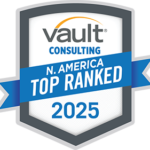Leading In5 is part of our commitment to helping leaders find creative ways to navigate and grow during these times of incredible post-COVID opportunity and phenomenal growth. This series features interviews with top business leaders from across sectors to gain their insights into leadership and success in transformational moments.
The Canadian gaming and lottery industry has seen incredible levels of change over the past two decades – including the disruptive impact of digital, changing cultural drivers and the impact of shifting demographics.
Paul Erickson, President and CEO at Western Canada Lottery Corporation (WCLC), is “known as a lifer in the lottery world because I’ve been here pretty much my whole career.”
I’ve had the privilege of working alongside Paul for several years. We’ve worked on strategy development and execution projects both at WCLC and on Canadian national lottery programs. Throughout our collaborations together I was struck by his leadership insights and connection to his team and his proven ability to wisely handle the waves of change that have defined the sector – and that’s why I went to him for his insights on leadership in times of disruptive change.
Paul has had a remarkable career journey and trajectory. He started out as a part time security officer in lottery and over the years moved into IT, audit and management – and then in 2018 he became the CEO of WCLC. At the time, the business was doing well and had been for many years. But there was also the pressing concern that the business also needed to evolve to ensure it could continue to grow in a changing marketplace.
“When I became the CEO, it was incredibly valuable to have this multi-function perspective on the business and the different teams. I really understood all the many moving parts and what they needed to function effectively and to move into the future.”
The following five lessons have been condensed from our conversation on leadership.
Lesson One: Empowerment Is the Foundation of Great Leadership
High impact leaders understand that it’s not about them – it’s about their team and how to best harness and optimize their skills. “As leaders, part of our job is to make our team look good.” says Paul, “and this means investing the time to understand your teams’ unique capabilities and competencies and then creating an environment for employees to feel genuinely comfortable taking on challenges individually, and collectively, and the impact and results will follow.”
To achieve this requires creating a high trust culture, one where, open and transparent conversations are part of the daily routine. A high trust environment requires a genuine tolerance for failure and empowering teams and managers to use any missteps as learning opportunities.
Lesson Two: Learning from the Missteps
Great leaders know that failure is the pre-requisite for innovation and invention – as IBM Thomas Watson, Sr., once said, “The fastest way to succeed is to double your failure rate.”
“When I was coming up in my career, the common perception in the business and management world was that a strong leader was one that had no tolerance for mistakes.
“But this approach has it completely backwards. What I found in my experience was it’s about acknowledging that people are human and will make mistakes. And when mistakes happen, what a leader does is turn it into a learning opportunity, including documenting the mistake and the learning – so that both are integrated into the organization.”
What my interactions with Paul show is the difference between “say” and “do”. Leaders will often acknowledge the realities of making mistakes. They say the right things in their speeches and in talking to staff. The great leaders, like Paul, put their “right” words into action.
Lesson Three: Get the Details – Delicately
High impact and successful leaders know that they need to gather multiple data points and perspectives in order to best lead their team and understand the full landscape of the market and business.
“This comes down to getting the details” explains Paul. “The key is to balance asking the right questions, without conveying a sense of micromanagement which undermines the larger goal of an empowered team.”
“When I talk with my team, I want to make sure that they have considered all the relevant factors and my role is to help them out and make sure they are equipped to be able to do a full analysis.”
To delicately gather these details, leaders need to ask “real questions” and then actively listen.
“Real questions” are ones crafted to gather the information that is actually needed and not just advice disguised as a question and actively listening means fully giving your team the space and attention that the conversation warrants.
Lesson Four: Be Vulnerable
The days of CEOs pretending to be all knowing and powerful are over. Great leaders are ones that know their weaknesses and blind spots and then intentionally and openly build teams to fill these gaps. As well, a CEO that is reluctant to admit mistakes or ask for help will create a culture and management team that does the same.
“As a leader it’s incredibly important to let people know that you don’t know everything, that you make mistakes. Show them often that you are human because it gives others the freedom to be imperfect too.”
“At a recent WCLC townhall I talked about my own experiences and struggles with mental wellness. I shared how during the pandemic, I realized that my own headspace was in a darker place than I realized and that I needed and then got assistance to help me navigate forward.”
“As a leader, opening up this very personal side of me was one of the most powerful actions that I’ve ever taken. And the response was phenomenal. People shared their own struggles and sent messages thanking me for doing this. It was incredible.”
Lesson Five: Create Natural Feedback Loops
In the past, feedback was reserved for the annual reviews. They were quite formally run and stressful for both managers and employees. However, research now shows that it’s far more effective to provide your team with more immediate, continual and casual feedback.
“Overall, we now have a greater degree of accountability for all staff. We’ve made strides in giving feedback on performance, both good and constructive. As a result, when I’m delivering annual performance appraisals, it’s really more of an end-of-year formality to get things documented.”
“What we’ve found is that by giving people both constructive or reinforcing feedback in the moment, we significantly improve the relationship and final outcomes.”
Building a positive culture starts with the tone and style set by leadership. The tone, words and the timing – all of these factors should be intentionally considered. And leadership should invest in feedback training for managers across levels and functions – since this is a way to operationalize building a positive, constructive and feedback safe environment.
I’m incredibly grateful to Paul for sharing his insights and reflections on leadership. And if you or someone on your team would be like to be featured in Leading In5 please get in touch:
Efram Lebovits,
Managing Partner




